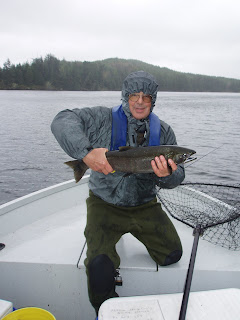
Greetings Anglers,
Winter steelhead are starting to show in good numbers on the Oregon Coast. These are just two of the several wild beauties hooked earlier this week. All your favorite techniques will work on these aggressive fish.
Here's this week's Siuslaw News story...
High Water Options for Steelhead and Salmon
We’ve all been there – you work hard all week and wait anxiously for the weekend. It starts raining Thursday night and pours all day Friday. By Saturday morning, your favorite river is 5 feet higher than you like to fish it and the color of café latte. Most fisherfolks would give up, but I say that’s a mistake! You can still catch fish under these conditions. I’ve had some of my best days during high water, when other anglers are still cleaning out the garage, or, even worse, sitting on the couch. There are few things more satisfying than catching fish when others think you’re crazy for even trying.
The “Whys” and “Wheres” of High Water Fishing
Simply put, you fish during high water because its when fish are moving. High water makes it easier for fish to navigate barriers such as falls and rapids. Rain is the cue for salmon and steelhead to move upriver for spawning. You can’t count on being able to find the fish as you would under normal water conditions. Let the fish find you. Also, forget about those favorite runs and drifts where the fish will be when the river drops and clears. Fish moving upstream will choose the path of least resistance, meaning they will be moving right along the bank, often within 10 feet of shore. There are several reasons for this. Salmon and steelhead will choose the path of least resistance. Moving along the bank means the fish are staying out of the main flow, which means they are using less energy. Imagine being faced with either moving slowly through the blackberries or taking a game trail, my guess is you will take the trail! Also, the softer flows available along the shore means less sediment in the water, which makes it easier for the fish to respire. Salmon and steelhead moving along the shore will be especially true in rapids. With high winter flows, the edge of the river might be the only place these fish will be able to move upstream. Concentrate your efforts near or in rapids, and very near the bank. These are the areas through which the fish will move.
Please join me next week as I talk more about high water options for salmon and steelhead.
See you on the water,
Action Jackson
(Please send comments or questions to Action Jackson at 268-6944 or www.actionjacksonfishing.com)














